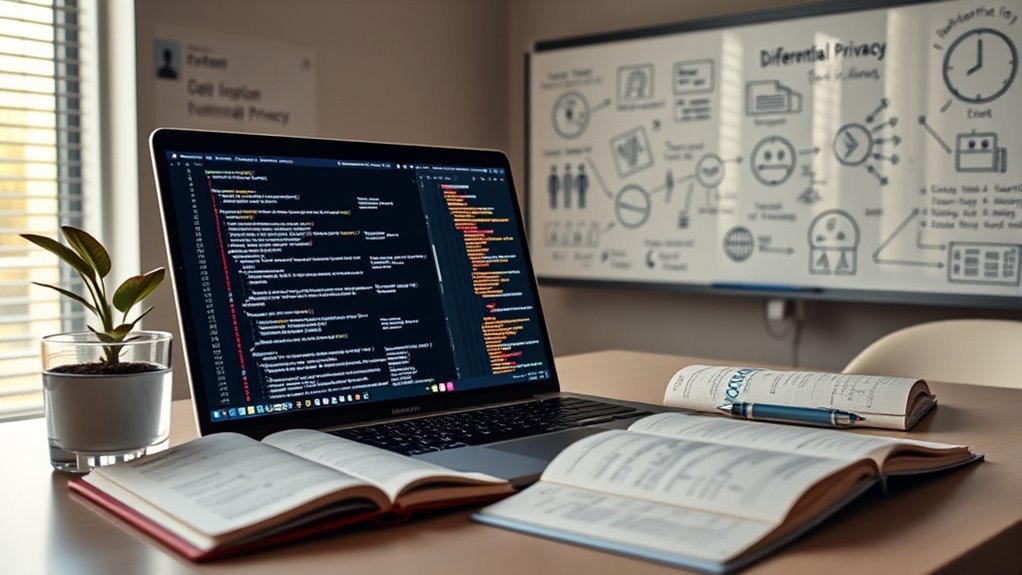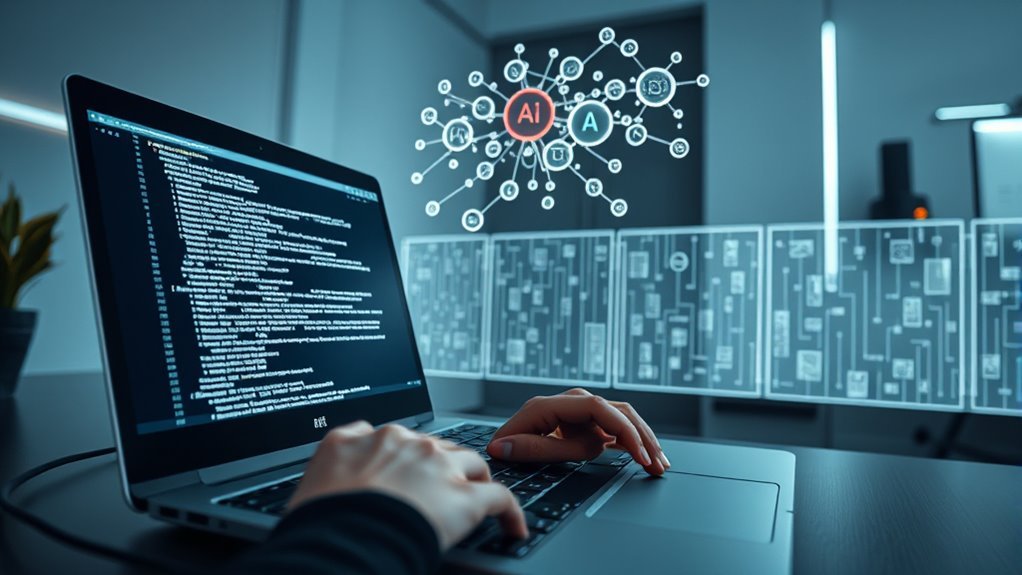When building AI models with differential privacy, you guarantee individual data points stay confidential by injecting carefully calibrated noise, balancing data utility with strong privacy guarantees. This approach mitigates risks like re-identification while complying with strict regulations. You’ll use techniques like noise addition, privacy budgets, and modified learning algorithms to protect sensitive information throughout training and inference. Implementing these measures strengthens your model’s data security without sacrificing accuracy, setting a solid foundation for responsible AI development and further exploration of advanced privacy methods.
Understanding the Basics of Differential Privacy

Although differential privacy is a complex concept, you’ll find its core principle straightforward: it guarantees that the output of an analysis doesn’t compromise the privacy of any individual in the dataset. By introducing carefully calibrated noise, differential privacy concepts maintain that the presence or absence of a single data point remains indistinguishable. This approach aligns with rigorous privacy definitions designed to quantify and limit potential information leakage. When you apply these principles, you maintain analytical utility while upholding individual data freedom. Understanding these privacy definitions lets you enforce strong protections, preventing adversaries from inferring sensitive information. In building AI models, mastering these fundamentals empowers you to balance data utility and confidentiality, preserving privacy without sacrificing insight in a security-focused manner.
Importance of Data Security in AI Development

Having a solid grasp of differential privacy lays the groundwork for addressing data security challenges in AI development. You must prioritize preventing data breaches by rigorously applying privacy regulations and compliance frameworks to safeguard sensitive information. Ethical considerations and respect for user consent are vital, ensuring users maintain control over their data ownership. Conducting thorough risk assessment enables you to identify vulnerabilities and implement robust defenses. Adhering to legal and ethical standards not only minimizes liability but also facilitates trust building with users who value their freedom and privacy. By embedding these principles into your AI models, you create systems that balance innovation with responsibility, protecting individuals while complying with evolving regulatory landscapes and reinforcing your commitment to secure, ethical AI development. Regular audits and compliance checks are crucial to maintain robust security systems and identify potential vulnerabilities in AI applications, strengthening ongoing data protection efforts and ensuring regulatory compliance.
Key Techniques for Implementing Differential Privacy

When you implement differential privacy, you must carefully employ techniques that mathematically guarantee individual data protection while preserving overall dataset utility. To maintain this balance, you rely on privacy preserving algorithms designed to limit information leakage. Mastering differential privacy techniques guarantees that your AI models respect user freedom and confidentiality without sacrificing performance.
Implementing differential privacy ensures data protection while maintaining AI model performance and user confidentiality.
Key methods include:
- Adding calibrated noise (e.g., Laplace or Gaussian) to outputs
- Employing randomized response mechanisms for query answers
- Using privacy budgets to control cumulative information exposure
- Applying data aggregation to obscure individual contributions
- Leveraging secure multiparty computation for distributed data handling
Differential Privacy in Machine Learning Algorithms
Since machine learning models often require access to sensitive data, incorporating differential privacy guarantees that individual information remains protected throughout training and inference. You’ll want to integrate differential privacy techniques directly into your algorithms, such as adding calibrated noise to gradients or outputs, to prevent data leakage. Privacy preserving algorithms modify the learning process to make certain that no single data point disproportionately influences the model, effectively obfuscating individual contributions. By applying mechanisms like the Laplace or Gaussian noise and carefully managing privacy budgets, you maintain rigorous security standards without exposing raw data. This approach lets you harness powerful AI capabilities while upholding user privacy, enabling freedom from data breaches and unauthorized access. Securing differential privacy in your machine learning pipelines is essential for robust, trustworthy AI development.
Balancing Privacy and Model Accuracy
You need to carefully balance the privacy-accuracy tradeoff when applying differential privacy to your AI models. Adding noise protects sensitive data but can degrade model performance if not properly optimized. Fine-tuning noise levels is critical to maintain robust privacy guarantees without sacrificing predictive accuracy.
Privacy-Accuracy Tradeoff
Although differential privacy provides robust safeguards against data leakage, it inevitably introduces noise that can degrade model accuracy. You’ll need to balance privacy metrics with accuracy benchmarks to maintain both security and utility. Understanding this tradeoff is essential—you want to protect individual data points without sacrificing model performance.
Consider these factors when traversing the privacy-accuracy tradeoff:
- The epsilon value’s impact on privacy guarantees versus noise magnitude
- How accuracy benchmarks shift as noise increases
- The dataset’s sensitivity and its influence on differential privacy parameters
- The model architecture’s resilience to noise-induced errors
- Regulatory requirements shaping acceptable privacy-accuracy thresholds
Optimizing Noise Levels
Striking the right balance between privacy and model accuracy hinges on carefully tuning the noise added to the data or gradients. You’ll need precise noise calibration to guarantee privacy optimization without excessively degrading model performance. Adding too much noise protects data but sacrifices accuracy; too little exposes sensitive information. Employ rigorous methods like the Gaussian or Laplace mechanisms, adjusting their parameters based on your privacy budget (ε) and sensitivity analysis. Iteratively test and validate to find the minimal noise level that satisfies your privacy constraints while maintaining model utility. This meticulous process empowers you to uphold data security and model reliability simultaneously, granting the freedom to deploy AI solutions confidently without compromising individual privacy or analytical value.
Tools and Libraries for Differential Privacy
Since implementing differential privacy can be complex, leveraging specialized tools and libraries is essential for building secure AI models. You’ll find differential privacy libraries and privacy preserving tools designed to integrate seamlessly into your workflows, ensuring rigorous data protection without sacrificing model utility. Here are key resources you can rely on:
- Google’s Differential Privacy Library: Provides algorithms for adding calibrated noise.
- IBM Diffprivlib: Offers a versatile toolkit for experimenting with privacy mechanisms.
- PySyft: Enables privacy-preserving machine learning with federated learning support.
- TensorFlow Privacy: Integrates differential privacy into TensorFlow training pipelines.
- OpenMined: An ecosystem of tools focused on secure, private AI development.
Real-World Applications of Differential Privacy in AI
When you deploy AI models in sensitive environments, ensuring data privacy is non-negotiable, and differential privacy offers a mathematically rigorous framework to achieve this. Differential privacy applications have become essential across sectors like healthcare, finance, and telecommunications, where safeguarding individual data is critical. You’ll find industry use cases such as private patient data analysis, fraud detection models, and user behavior analytics that leverage differential privacy to provide robust privacy guarantees without compromising model utility. By injecting calibrated noise during model training or query responses, differential privacy mitigates risks of re-identification attacks. This balance between data utility and privacy empowers you to build AI systems that respect user freedom and meet stringent regulatory standards, enabling secure innovation while protecting sensitive information in real-world deployments. Implementing differential privacy within a broader data privacy practices framework ensures compliance with regulations like GDPR and fosters greater trust among stakeholders.
Challenges and Future Directions in Privacy-Preserving AI
Although differential privacy has advanced the security of AI systems, you still face significant challenges in balancing privacy guarantees with model performance, scalability, and usability. Steering through evolving privacy regulations while ensuring ethical considerations and user consent complicates implementation. You must also address algorithm transparency to foster trust building and respect data ownership. Future directions require deeper stakeholder collaboration to overcome compliance challenges and integrate privacy seamlessly.
Balancing privacy, performance, and transparency remains key to ethical, user-trusted AI development.
- Aligning privacy regulations with scalable AI architectures
- Ensuring robust user consent without compromising model utility
- Enhancing algorithm transparency for auditability and trust
- Clarifying data ownership to prevent misuse and legal conflicts
- Fostering multi-disciplinary stakeholder collaboration for ethical compliance
Addressing these areas is critical to advancing privacy-preserving AI that empowers users without sacrificing freedom or security. Emphasizing transparency, accountability, and inclusivity in AI design is essential to building ethical and trustworthy privacy-preserving systems.



